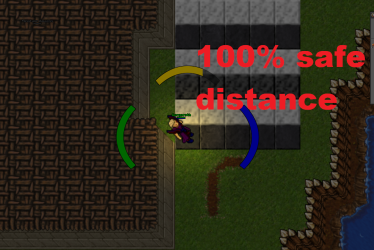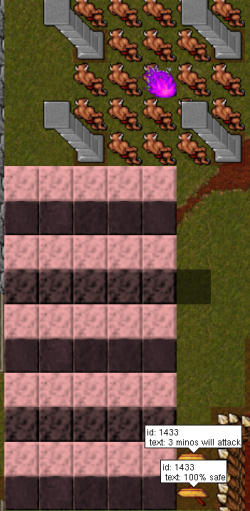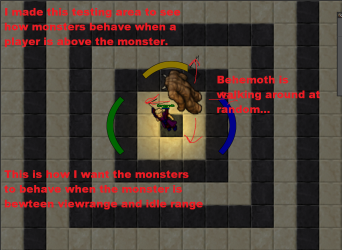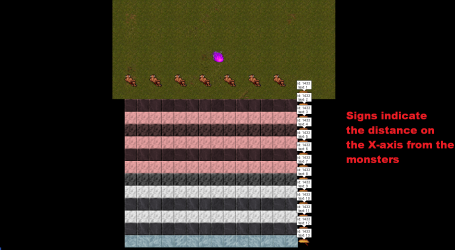krafttomten
Well-Known Member
The way I remember, monsters in real Tibia had a different non-idle range from their targeting range. In TFS 1.X, this does not seem to be the case. Let me explain what I mean. If I stand still in any hunting location on my TFS server, as soon as I have killed all the visible monsters, I am safe. But in real Tibia, the monsters could walk around at random, even if they were too far away from me to see. As a result, if I were to stand still in a cave, a nearby monster would eventually walk close enough to come within targeting range.
I'm not sure if TFS 1.X is coded this way. Maybe it is the same value that determines the monsters non-idle range and the monsters targeting range, or maybe the values are so close to eachother so that it doesn't make a difference.
I would like to change the monster behaviour so that the monsters start to move around when they are within ~30 squares of any player, and target any player that are within ~10 squares. Also, the player should only prevent spawn within ~10 squares, so that it doesn't feel safe to go AFK, even for a minute, while hunting. It would also be good if the monsters would walk back to spawn if they moved too far away.
Is this possible? I am currently using TFS 1.3, but will change into 1.4 so I prefer an answer that works with TFS 1.4 (if there is a difference) Any help is much appreciated!
p.s. I have tried to find the relevant code for several hours now, and rewritten this post three times with different ideas of how the code works, only to find that I had misunderstood something fundamentally, resulting in me starting over from scratch. I figured it's maybe better to just ask someone who actually knows how the system works for an answer. If I cannot get an answer, maybe I will be able to get a hint on where to start.
edit*
From what I have found, this is way beyond me to implement. I need to learn a lot more C++. But I would highly encourage the implementation of this system in the official TFS. The first reason is that the original Tibia worked like this. The second reason is that it is a really important feature of the game. Without it, the world don't feel dangerous. If the monsters are walking around, it is terrifying to go close to a dragon spawn with a low level character. Not to mention a giant spider spawn. Like the GS spawn on the way to the dark cathedral. It used to be terrifying to go there because you never knew if you would get annihilated on the way by a giant spider. That feeling of not being able to know where the enemies are lurking is an amazing and terrifying game mechanic.
The monsters moving around also creates a lot of randomness at the hunting grounds. Sometimes you will face two monsters in a room, the next time you face four of them. This makes hunting a lot less linear and because of that, less booring.
I'm not sure if TFS 1.X is coded this way. Maybe it is the same value that determines the monsters non-idle range and the monsters targeting range, or maybe the values are so close to eachother so that it doesn't make a difference.
I would like to change the monster behaviour so that the monsters start to move around when they are within ~30 squares of any player, and target any player that are within ~10 squares. Also, the player should only prevent spawn within ~10 squares, so that it doesn't feel safe to go AFK, even for a minute, while hunting. It would also be good if the monsters would walk back to spawn if they moved too far away.
Is this possible? I am currently using TFS 1.3, but will change into 1.4 so I prefer an answer that works with TFS 1.4 (if there is a difference) Any help is much appreciated!
p.s. I have tried to find the relevant code for several hours now, and rewritten this post three times with different ideas of how the code works, only to find that I had misunderstood something fundamentally, resulting in me starting over from scratch. I figured it's maybe better to just ask someone who actually knows how the system works for an answer. If I cannot get an answer, maybe I will be able to get a hint on where to start.
edit*
From what I have found, this is way beyond me to implement. I need to learn a lot more C++. But I would highly encourage the implementation of this system in the official TFS. The first reason is that the original Tibia worked like this. The second reason is that it is a really important feature of the game. Without it, the world don't feel dangerous. If the monsters are walking around, it is terrifying to go close to a dragon spawn with a low level character. Not to mention a giant spider spawn. Like the GS spawn on the way to the dark cathedral. It used to be terrifying to go there because you never knew if you would get annihilated on the way by a giant spider. That feeling of not being able to know where the enemies are lurking is an amazing and terrifying game mechanic.
The monsters moving around also creates a lot of randomness at the hunting grounds. Sometimes you will face two monsters in a room, the next time you face four of them. This makes hunting a lot less linear and because of that, less booring.
Attachments
-
 safe distance tibia.png729.6 KB · Views: 67 · VirusTotal
safe distance tibia.png729.6 KB · Views: 67 · VirusTotal -
 3 mino.png1 MB · Views: 67 · VirusTotal
3 mino.png1 MB · Views: 67 · VirusTotal -
 showspawn.png442.6 KB · Views: 67 · VirusTotal
showspawn.png442.6 KB · Views: 67 · VirusTotal
Last edited:


